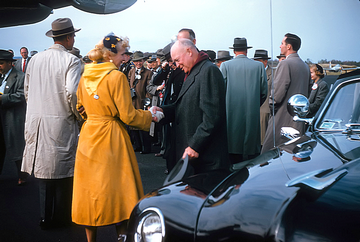Special Thanks to FotoBridge Photo Scanning Service Client Philip Devlin for use of photo. President Eisenhower greets dignitaries at Bradley field Windsor Locks, CT in 1959 for the dedication of the terminal building.
 More and more universities, libraries, museums and other organizations with large document and photograph collections are finding that digitizing large photo collections is the solution to providing unrestricted access to their collection within a secure environment. With digital imaging, photographs and documents can be reproduced as often as needed without any degradation of quality. Actually, if done correctly, optimizing the quality for increased results of the image can enhance the overall features of your end product. However, in order to obtain the most value from your digital collection, you must be able to start with quality images.
More and more universities, libraries, museums and other organizations with large document and photograph collections are finding that digitizing large photo collections is the solution to providing unrestricted access to their collection within a secure environment. With digital imaging, photographs and documents can be reproduced as often as needed without any degradation of quality. Actually, if done correctly, optimizing the quality for increased results of the image can enhance the overall features of your end product. However, in order to obtain the most value from your digital collection, you must be able to start with quality images.
Yes, enhancements can be made to images, but you still must be able to start with fidelity in the appearance of the original image. Regrettably, most historical photo collections are not of high quality. In many of these cases, they are only suitable to be digitized for document identification and collection.
In some cases, the equipment used in the digitizing process such as the scanner, camera, operating system or software can be used to enhance the quality of the original photo if done properly. Most times, the technical aspects of this are better performed by an imaging expert.
There are many techniques that can be used to ensure high-quality imagery, most times techniques are employed on a case-by-case basis based upon the image quality requirements, document size and quantity, along with the acquisition speed required.
An untrained viewer may describe the quality of a digital image as lifelike, well-focused, sharp or colorful. Though these may be all true, they are up to the interpretation of the observer, however, to the trained professional they may not be as close to the original image quality as desired.
There are more objectives methods to describe the resulting presentation of an imaging system in the quality of the images it produces. When high-quality image characteristics are required, the services of an imaging expert may be called for.
By optimizing the factors that affect image quality, increased image results can be obtained.
The interpreted quality of your digital image, and its utility for digitizing, are contingent upon several factors, to include:
- quality of the original images
- methods of digitization and the conversion characteristics selected
- reformatting, resampling, and reduction levels
- viewer's computer monitor, software and printer
- quality of the environment the images will be viewed in
Some of these aspects are technical in nature, some can be controlled by the image holder, and others are only control by the end-user. If the image originator does not pay adequate attention to producing high-quality digital files, when digitizing large photo collections, the end-user experience will be less than desired and will leave the end-user with little to do to improve the image quality.



